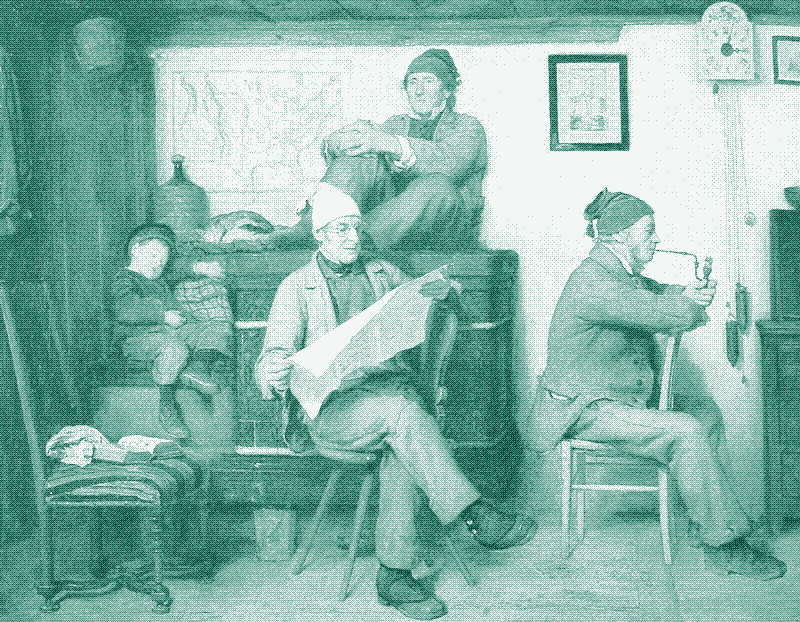
These days, we provide thermal comfort in winter by heating the entire volume of air in a room or building. In earlier times, our forebear’s concept of heating was more localized: heating people, not places.
They used radiant heat sources that warmed only certain parts of a room, creating micro-climates of comfort. These people countered the large temperature differences with insulating furniture, such as hooded chairs and folding screens, and they made use of additional, personal heating sources that warmed specific body parts.
It would make a lot of sense to restore this old way of warming, especially since modern technology has made it so much more practical, safe and efficient.
Conduction, Convection, Radiation
Most modern heating systems are primarily based on the heating of air. This seems an obvious choice, but there are far worthier alternatives. There are three types of (sensible) heat transfer: convection (the heating of air), conduction (heating through physical contact), and radiation (heating through electromagnetic waves).
The old way of warming was based upon radiation and conduction, which are more energy-efficient than convection. While convection implies the warming of each cubic centimetre of air in a space in order to keep people comfortable, radiation and conduction can directly transfer heat to people, making energy use independent of the size of a room or building.
First, let’s have a look at the different methods of heat transfer in some more detail. Conduction and convection are closely related. Conduction concerns the transfer of energy due to the physical contact between two objects: heat will flow from the warmer to the cooler object. The speed at which this happens depends on the thermal resistance of the substance.
For example, heat is transferred much faster through metal than through wood, because metal has a lower thermal resistance. This explains why, for instance, a cold metal object feels much colder than a cold wooden object, even though they both have the same temperature.
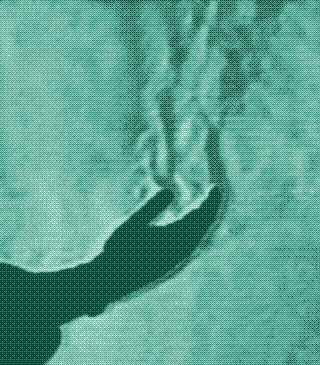
Conduction not only occurs between physical objects, but also between physical objects and gasses (like air), and between gasses mutually. Each physical object that is warmer than the air that surrounds it, heats up the air in the immediate vicinity through conduction. By itself, this effect is limited, because air has a high thermal resistance - that’s why it forms the basis of most thermal insulation materials.
However, the air that is warmed by conduction expands and rises. Its place is taken by cold air, which is heated in turn, expands, rises, and so on. This plume of warm air that rises from every object that is warmer than the surrounding air, is called convection.
Radiation, the third form of sensible heat transfer, works in a very different way from conduction and convection. Radiant energy is transferred through electromagnetic waves, similar to light. More precisely, it concerns the part of the electromagnetic spectrum that’s called infrared radiation. Radiation doesn’t need a medium (like air or water) for heat transfer.
It also works in a vacuum and it’s the most important form of heat transfer in outer space. The primary source of radiant energy is the sun, but every object on earth radiates infared energy as long as it has mass and a temperature above absolute zero. This energy can be absorbed by other objects with a lower temperature. Radiant energy doesn’t have a temperature. Only when it hits the surface of an object with mass, the energy can be absorbed and converted into heat.
Thermal Comfort at Low Air Temperatures
Because of the general use of central air heating (and cooling) systems, we have come to believe that our indoor thermal comfort depends mainly on air temperature. However, the human body exchanges heat with its environment through convection, radiation, conduction and evaporation (a form of “latent” heat transfer).
Convection relates to the heat exchange between the skin and the surrounding air, radiation is the heat exchange between the skin and the surrounding surfaces, evaporation concerns the moisture loss from the skin, and conduction relates to the heat exchange between a part of the human body and another object that it’s in contact with.
If the share of radiation or conduction in the total heat transfer increases, people can be perfectly comfortable at a lower air temperature during the heating season
In winter we can remain comfortable in lower air temperatures by increasing the share of radiation or conduction in the total heat transfer of a space. The opposite is also true: conduction and radiation can make people feel uncomfortable in spite of a high air temperature. For example, a person standing on a cold floor with bare feet will feel cold, even if the air temperature is a comfortable 21ºC (70ºF). This is because the body loses heat to the floor through conduction. A hot cup of soup in the hand, floor heating, or a heated bench have the opposite effect, because heat is transferred from the warm object to the body through conduction.
Radiant heat can make people comfortable at a lower air temperature, too. The obvious example is direct sunlight. In spring or autumn, we can sit comfortably outside in the sun wearing only a T-shirt, even if the air temperature is relatively low. A metre away, in the shade, it can be cold enough to need a jacket, although the air temperature is more or less the same. In summer, we prefer the shade. The difference is explained by the radiant energy of the sun, which heats the body directly when it is exposed to sunlight. This higher “radiant temperature”, which can be measured with a black-globe thermometer, allows thermal comfort at a colder air temperature in winter.
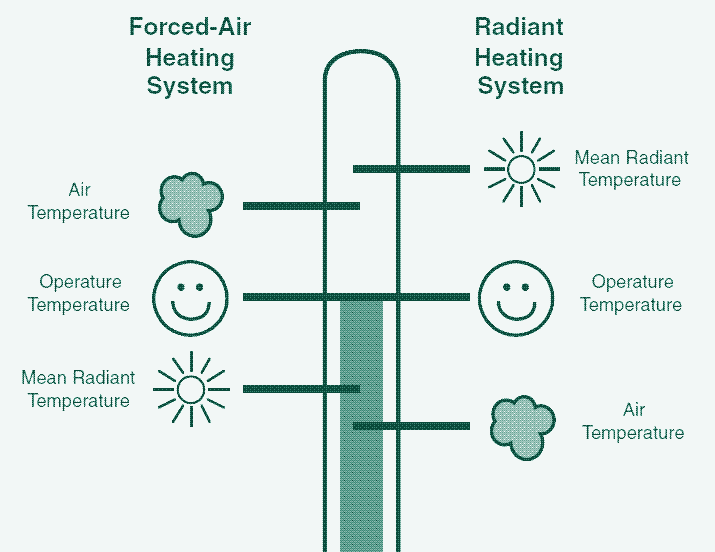
It should be noted that on earth, radiation always goes hand in hand with convection. Because air has little mass, the radiant energy of the sun doesn’t heat the air directly. However, it does so indirectly. The radiant energy of the sun is absorbed by the earth’s surface, where it is converted to heat. The warmer earth’s surface then slowly releases this heat to the air through the earlier described mechanisms of conduction and convection. In other words, it’s not the sun but the earth’s surface that heats the air on our planet.
The radiant temperature is equally important when heating a building, no matter which heating system is used. Indoors, the radiant temperature represents the total infrared radiation that is exchanged between all surfaces in a room. Radiant heating systems, which we will discuss later on, work in a similar manner as the sun: they don’t heat the air but the surfaces in a space, including human skin, raising the radiant temperature and providing thermal comfort at a colder air temperature. The use of radiant heating is more practical indoors, where environmental factors are under control. If a wind picks up outside, for example, the warming effect of the sun quickly disappears.
It’s not the sun but the earth’s surface that heats the air on our planet
A 100% radiant heating system doesn’t exist, because both the radiant heating surface and the irradiated surfaces make contact with the air and warm it by conduction and convection. However, this heating of the air has a delayed onset and is more limited than in the case of a direct air heating system. Likewise, an air heating system will also raise the radiant temperature in a space, because the hot air warms the building’s surfaces through conduction. But again, the increase of the radiant temperature is slow and limited in comparison to a radiant heating system.
As with conduction, radiation can also make people uncomfortable in spite of warm air temperature. If we are seated next to a cold window, our body will radiate heat to this cold surface, making us feel cold even when the air temperature is a comfortable 21ºC (70ºF). In short, neither a high air temperature nor a high radiant temperature are a guarantee of thermal comfort. The best understanding of the thermal environment in a space is given by the “operative temperature”, which is a weighted average of both.
The Old Way of Warming
Before the arrival of central air heating systems in the twentieth century, buildings were mainly heated by a central radiant heat source, such as a fireplace or a wood, coal or gas stove. Usually, only one of the rooms in a building was heated. But even within this room, there were large differences in comfort depending on your exact location in the space. While air heating distributes warmth relatively evenly throughout an area, a radiant heating source creates a local microclimate that can be radically different from the rest of the room.
This is because the energy potential of a radiant heat source decreases with distance. It’s not that the infrared waves become weaker, but that they become more dispersed as they are fanning out from a specific source. This is shown in the two illustrations below, which appear in Richard Watson’s “Radiant Heating and Cooling Handbook”. The drawing on top shows the radiant heat distribution (or “radiant landscape”) in a room, seen from above, which is warmed by a forced-air heating system. The average radiant temperature in the space is 20ºC (68ºF). Except for the influence of a cold window surface (at the top of the illustration), the radiant temperature is relatively constant throughout the room.
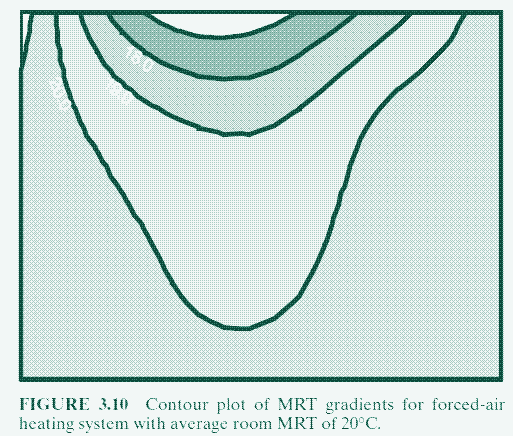
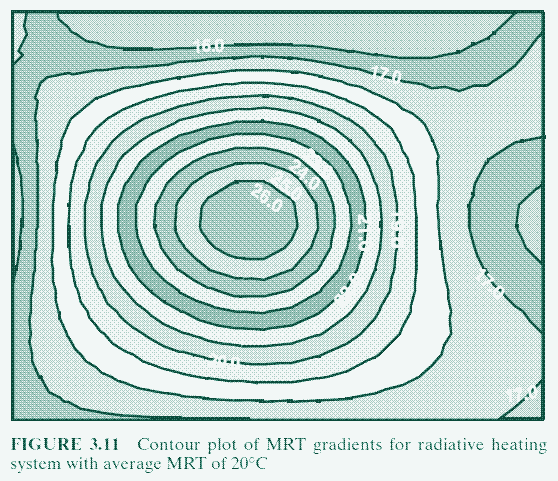
The second illustration shows the same room, again with a mean radiant temperature of 20ºC (68ºF), but now heated with a radiant heat source which is located at the centre of the ceiling. It concerns an electric longwave infrared panel, a new technology that we will explain in the second part of this article, but a fireplace in the middle of the room would give a similar result. The radiant landscape is now very different. The highest radiant temperature is measured in the middle of the room, right below the heating panel. The radiant temperature then decreases rapidly in concentric circles towards the sides of the room. The difference between minimum and maximum radiant temperature is much larger than in the case of an air heating system.
In an air-heated room, it doesn’t matter much where you are. In a room heated by a radiant heating source, location is everything.
Of course, a different location of the radiant heating surface, or a combination of two or more radiant heating surfaces, would again present a very different radiant landscape. Furthermore, as with solar radiation, other objects can throw shadows, which means that even the location of the furniture can have an effect on the heat distribution in a room. Also note that the heterogeneous distribution of the radiant temperature will be somewhat tempered by the homogeneous character of the air temperature, no matter which heating system is being used.
Energy-Efficiency
In an air-heated room, it doesn’t matter much where you are. In a room heated by a central radiant heating source, location is everything. The mean radiant temperature can be optimal, but the radiant temperature in parts of the space may be too low. But the opposite is also possible: the mean radiant temperature can be too low, while at certain locations the room is perfectly comfortable. This is the ancient principle of spot or zone heating, which is impossible to realize with an air heating system. Instead of heating the entire space, our ancestors only heated the occupied parts of a building.

A similar thing happens on the vertical plane. Warm air rises, so that most heat ends up under the ceiling, where it is of little use. With radiant heating, it’s perfectly possible to only heat the lower part of a space, no matter how high the ceiling is. Radiant heat doesn’t rise, unless the radiant heating surface is aimed upwards. In conclusion, instead of heating the entire volume of air in a space, a radiant heating system can heat only that part of a space which is occupied, which is of course much more energy efficient.
Unless the room is very small or very crowded, only a very small part of the energy used by an air heating system benefits people. On the other hand, almost all the energy used by a radiant heating system is effectively heating humans.
Local Insulation
A problem with the heterogeneous indoor climate of old times was radiant assymetry—the difference in radiant temperature between distinct parts of the body. A person sitting in front of an open fire will receive sufficient radiant heat on one side of their body, while the other side loses heat to the cold air and surfaces at the opposite half of the room. The body can be in thermal balance—the heat loss on one side equals the heat gain on the other—but if the temperature differences are too large, thermal comfort will not be obtained.
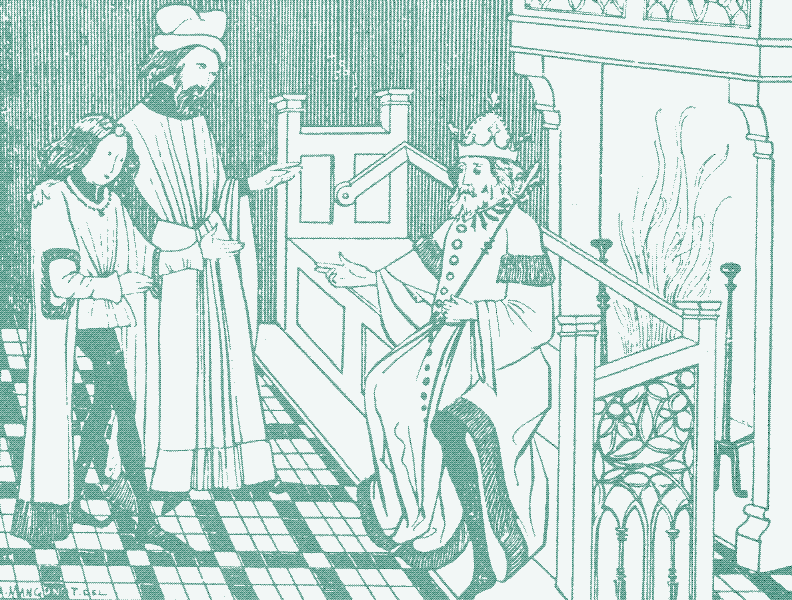
The problem is illustrated on the engraving above. The back of the bench could be switched from side to side. By regularly turning the body to the fire and then away from it, both the front and the back of the body could be heated alternately. Although radiant assymetry can be an issue with forced-air heating systems, it’s much more likely to appear in spaces that are warmed by a a radiant heat source. In historical buildings, the difference in surface temperatures was aggravated by the fact that building surfaces were not insulated. Drafts, another cause of local thermal discomfort, were also a problem in old buildings, because they were anything but air-tight.
To create a comfortable microclimate without radiant assymetry or draft, our forefathers supplemented local heating with local insulation
To create a comfortable microclimate without radiant assymetry or drafts, our ancestors supplemented local heating with local insulation. One example was the hooded chair. This chair, which could be upholstered or covered with leather or wool blankets, fully exposed people to a radiant heat source, while protecting their back from the drafts and the low surface temperatures behind them.
At the same time, the shape of the furniture ensured that a greater share of the radiant heat emitted by the fire was effectively used: the chair was heated directly by the fire through radiation, and this heat was transferred to the person sitting in it. Recent research has shown that the insulation value of these types of chair amounted to at least 0.4 clo, which corresponds to the insulation value of a heavy pullover or coat. Some hooded chairs could host more than one person.
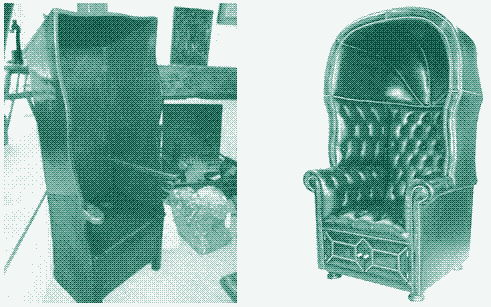
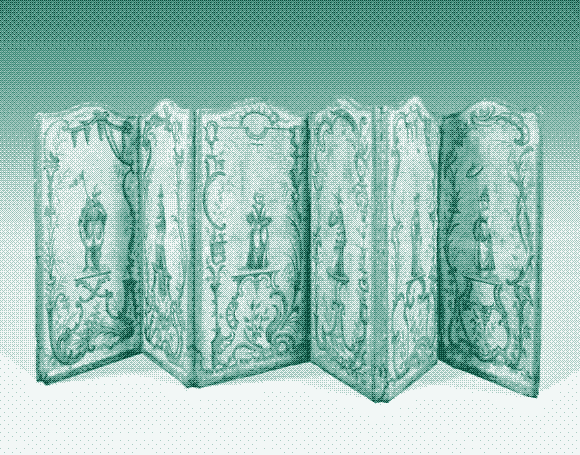
An additional solution, which could also be used alone, was the folding screen. The folding screens used as winter furniture were insulated with fabrics or built with heavy wood panels. They could be placed behind an insulated chair, or behind a table, for instance. Like the hooded chair, the folding screen protected the back of a person against drafts and cold temperatures, creating a comfortable microclimate.
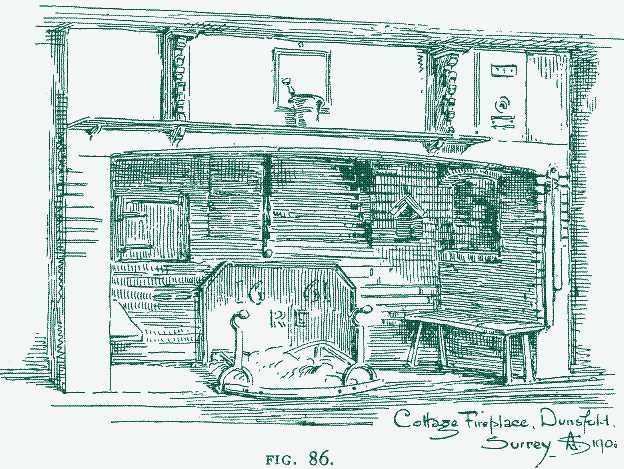
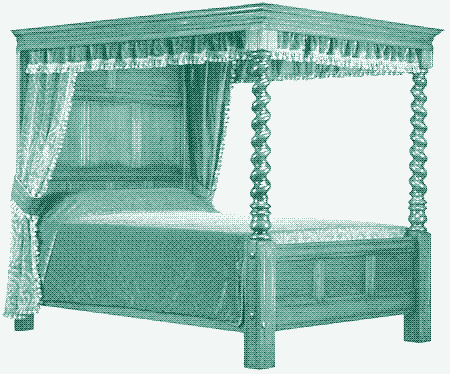
A third example of local insulation were special sitting areas close to the fireplace. These could be benches placed between the fire and the side walls of the fireplace, or a niche in the wall with a built-in seat. In both cases, a person would lean against a wall that was warmed by the fire and protected from drafts. In some cases, the fireplace itself was placed in a room-inside-a-room. In the bedroom, which often remained unheated, yet another piece of furniture was aimed at providing a microclimate: the four poster bed, which had a canopy and thick curtains. When the curtains were closed, drafts were eliminated and body heat was trapped inside.
Portable Heating Systems
The apparent downside of spot heating is that you have to be in a specific location in order to be comfortable. In earlier times, the family gathered around the fireplace or the stove when no physical work had to be done, or when the body had to be warmed up after a long stay in a cold environment. Other locations in the room, as well as unheated rooms, were better suited for activities which required a higher metabolism. People were “migrating” throughout the room and throughout the house in search of the climate that suited their needs best.
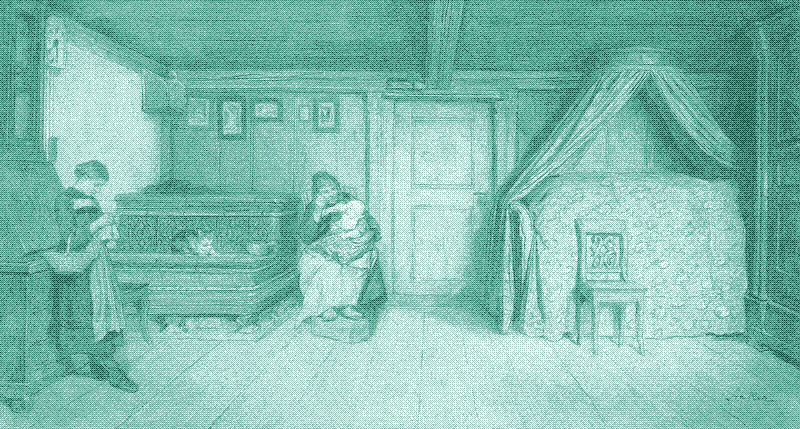
However, the use of radiant heat sources and local insulation were also complemented by portable heating sources which transferred heat through radiation, convection and/or conduction. These could be used to further increase thermal comfort in the presence of a central heat source, and were also helpful in bringing warmth to other locations. Portable heating systems were designed especially to heat the feet or the hands: the parts of the body that are most sensitive to cold.
Personal heating sources allowed people to enjoy the heat from the central fireplace in unheated rooms, or even outside the house
An example is the foot stove, a box with one or more perforated partitions, which contained a metal or earthenware bowl or pan filled with embers from the fireplace. The feet were placed on top of the stove and the often long garments worn in those days increased the effect of the small heating device: the warmth was guided through a skirt or a chamber coat along the legs to the upper body. The upper part of the stove was made of wood or stone, as these materials have low thermal conductivity to avoid burns.
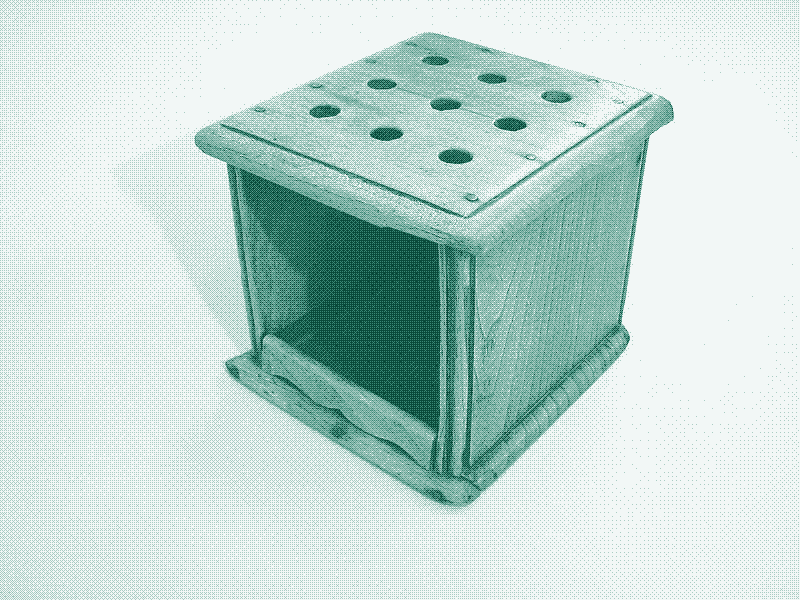

In many cultures worldwide, similar heat sources were used for warming the hands. They were made from metal or ceramics and were filled with embers from the fireplace, or with coal or peat. These personal heating sources also allowed people to enjoy the heat from the central fireplace or stove outside the house. They were taken in unheated coaches and railcars, or to Sunday Mass. Poor people made use of heated stones or bricks, or even heated potatoes put in coat pockets.
For heating the bed, people made use of brass bedpans with a long handle which were shoved underneath the mattress. Some beds had a bed wagon: a large, wooden frame designed to hold a pot of glowing fuel in the centre of the bed. In the 19th century, following the arrival of the public water supply, the use of ceramic hot water bottles became common – water is a much safer heat medium than smouldering fire. These devices, which were often protected by a fabric cover, were used as foot warmers, hand warmers, or bed warmers.
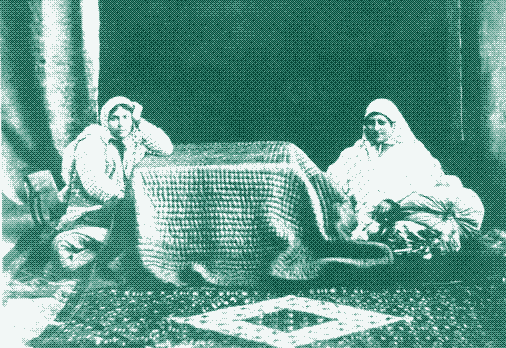
Some peoples took the concept of the foot stove one level higher. The Japanese had their “kotatsu”, a movable low table with a charcoal heater underneath. A thick cloth or quilt was placed over the table to trap the heat and the whole family slid their legs under the table, sitting on the floor. As with the European and American foot stoves, contemporary clothing increased the effect of the device. The heat of the charcoal burner was transferred through the traditional Japanese kimono, warming the whole body. Similar heating devices were used in Afghanistan (such as the “korsi”), as well as Iran, Spain and Portugal.
Conductive Heating Systems
Some historical radiant heating systems also transferred heat through conduction, further improving efficiency and comfort. More than 3,000 years ago, the Chinese and the Koreans built heating systems which were based on trapping smoke gases in a thermal mass. The northern Chinese “kang” (“heated bed”) was a raised platform made from stone, masonry or adobe, which occupied about half of the room. As the name indicates, the kang was in the first place a heated bed, but the platform was also used during the day as a heated work and living space. The “dikang” (“warmed floor”), which was typical in North-Eastern China, worked in the same way as the kang, but had a larger floor area.
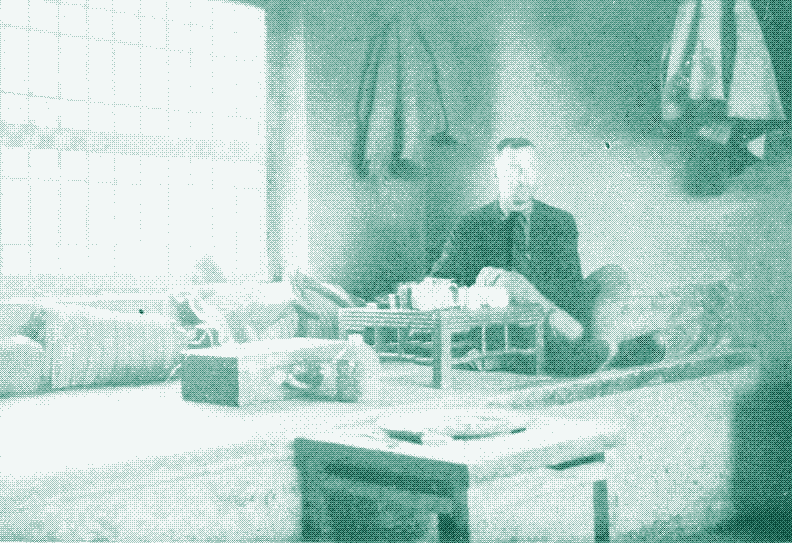
The Koreans used the “ondol” (“heated stone”), which was a wall-to-wall platform. A similar heating system in Afghanistan, the “tawakhaneh” (“hot room”) is possibly the oldest of these systems: its use may date back 4,000 years. In all these systems, the heat of an open fire was led underneath the platform to a chimney at the other side of the room. Both the fireplace and the chimney could be in the room or in adjacent rooms. The heat of the hot smoke gases was transferred to the thermal mass of the platform, which slowly released the warmth to the space. Conduction was as important as radiation and convection in the total heat transfer.
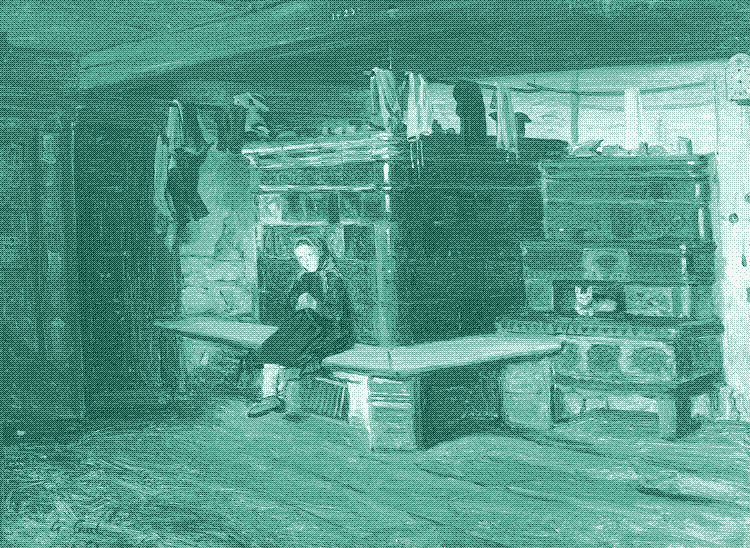
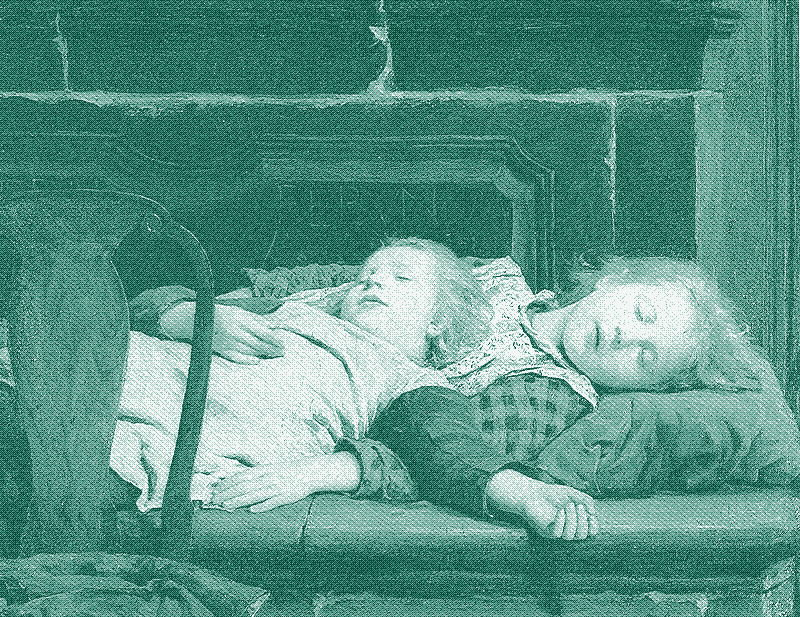
These ancient Eastern heating systems are somewhat reminiscent of the European tile stoves that appeared in the middle ages. Tile stoves (or “masonry heaters” as they are known in the USA) are heat accumulating wood stoves that make use of a high thermal mass to burn wood at very high temperatures, which is cleaner and more efficient. The smoke gases are trapped in a labyrinth of smoke channels, transferring most of the heat to the masonry structure before leaving the chimney.
Tile stoves produce a large share of radiant heat, but on top of this they allow heat transfer through conduction, as many tile stoves had built-in platforms to sit or sleep on. Even if these platforms were not there, wooden benches were placed next to the stove so that one could lean against the warm (but not too hot) surface.
Why We Also Need Modern Technology
In conclusion, all historic heating systems used radiation and/or conduction as the primary modes of heat transfer, while convection was merely a by-product. It makes good sense to return to this concept of heating, but that doesn’t mean that we have to go back to using fireplaces and carrying burning embers around the house. While the old concept of heating is more energy-efficient, the same cannot be said of most of the old heating devices.
While the old concept of heating is more energy efficient, the same cannot be said of most of the old heating devices.
Fireplaces, for one thing, are hugely inefficient, because most of the heat escapes through the chimney. They also suck in large amounts of cold air through cracks and gaps in the building envelope, which cools the air indoors and introduces strong drafts. Owing to this, fireplaces can even have negative efficiency as far as the air temperature is concerned: they can make the room colder instead of warmer. Stoves do better, but they remain relatively inefficient and have to be fired regularly, just like a fireplace. And for both options, air pollution can be substantial.
The (improved) tile stove is the only ancient heating system that can still be recommended, but we have far more options now, such as electric and hydronic radiant and conductive heating systems. These are more efficient, more practical, and safer than the heating sources of yesteryear. In the next two articles, we investigate how the old way of warming can be improved upon by modern technology, and how much energy could be saved.
Sources (in order of importance):
- Stralingsverwarming: Gezonde Warmte met Minder Energie, Kris De Decker, 2015
- Keeping Warm in a Cooler House. Creating Comfort with Background Heating and Local Supplementary Warmth (PDF). Historical Scotland Technical Paper 14, Michael Humphreys, Historic Scotland, 2011
- Radiant Heating and Cooling Handbook (Mcgraw-Hill Handbooks), Richard Watson, 2008
- Human Thermal Environments: The Effects of Hot, Moderate, and Cold Environments on Human Health, Comfort, and Performance, Third Edition, Ken Parsons, 2014
- The Book of Masonry Stoves: Rediscovering an Old Way of Warming, David Lyle, 1984
- History of radiant heating and cooling systems, part one. Robert Bean, Bjarne W. Olesen, Kwang Woo Kim, in “ASHRAE Journal”, January 2010, pp. 40-47
- Adaptive Thermal Comfort: Principles and Practice, Fergus Nicol, Michael Humphreys & Susan Roaf, 2012
- Dictionnaire de l’Ameublement et de la Décoration depuis le XIII siècle, Henry Havard, 1887-1890.
- Foot warmers: hot coals, hot water. Home Things Past.
- Bed warmers. Old & Interesting.
- Muff warmers & other antique hand warmers. Home Things Past.
- Körperwärmespender. Website.
Reactions
To make a comment, please send an e-mail to solar (at) lowtechmagazine (dot) com. Your e-mail address is not used for other purposes, and will be deleted after the comment is published. If you don’t want your real name to be published, sign the e-mail with the name you want to appear.
Reactions
Jodie
That’s a pretty skilful article, and wonderful art from the archives. I cant help but surmise that modern heating of space permits far greater levels of comfort, health and creativity for us in this age. Central heating is probably overused by many, and radiant heat can be part of a more sustainable solution, particularly for heating smaller spaces. I think the answer lies in good archeitecture and insulation and more sensitive thermostat and digital controls for space heating.
Gerfried
In this respect I have filed two patents (which will not be granted). One for controlling infrared lamps integrated in the ceiling bound illumination, according to the position of the persons (and the temperature). The second invention relates to the integration of an heating mat into a tubular background illumination. Furthermore the tube features a fan for destroying the temperature gradients in the room. The information will be public domain soon it is published by the patent office and the re-registration is also refused. Here are the Links to the patent office:
http://see-ip.patentamt.at/NPatentSuche/Details/471b70d8-2ffc-47d1-a3d8-f1b65e417cbb
http://see-ip.patentamt.at/NPatentSuche/Details/483db702-798f-4f80-9e74-c5a94bb15750
http://see-ip.patentamt.at/NPatentSuche/Details/282f1662-6e66-4b0f-b634-810df7aa364f
The Bare Necessities
Thank you so much for this article, and the illustrations are excellent. In winter in the US I get so frustrated by the way public transportation is heated: buses and subway cars are filled with heated air which is much too hot, and gives you a headache almost immediately (the opposite of thermal comfort, really). Moreover, it is now forbidden to open up the bus windows (they have been nailed shut), so one is forced to sit in silence, wearing full winter gear, breathing the hot hot air, and wishing for a world with less convection.
Leo Comerford
The MIT Local Warming project (Economist article) seems to have the best approach to spot heating based on stationary equipment. It apparently overcomes the radiant assymetry problem by using two or more spot lights to focus the user from different directions simultaneously. (Gerfried’s first idea seems to be much the same.)
Failing that, there are the electrical heated jackets which are becoming increasingly popular: spot heating taken towards its logical conclusion. But it can probably be taken even further. The AVAcore CoreControl glove can apparently adjust the body’s core temperature more quickly and (I assume) more efficiently than other means of heating or cooling. Something similar that didn’t block the hand (maybe a sleeve for the forearm?) might be suitable for continuous use.
Matthias
Nice article, btw the romans has some smart heatings systems too.
What is not discussed here is vaporization and condensation. If the temperature is lower than the dew point water will condensate. This will lead to mould and other unpleasant occurrences which can seriously can harm health and also destroys the building structure. So all surface temperatures as well as air temperatures have to be higher than the dew point. Of course it is possible to dry the air and lower the dew point but dry air is also not very healthy.
So generally the end heating the air is the mist economical and ecological way of heating.
Don’t forget that every car or truck will produce a lot of heat. 60%-80% of the energy content of the fuel is converted into heat energy which is wasted and leaves the vehicles exhaust.
so we could use a engine in our house using the exhaust heat to heat our home and drives a generator which provides us electricity for the house and car. Those systems are available for oil and natural gas. Powerplants fired by biomass or coal can provide heat for whole cities.
Russell
I’ve been reading up en rocket mass heaters. There seems to be many people improving them at the moment. There is a Dutch guy whose name escapes me at the moment but he’s quite easy to track down on google, and an American couple called Ernie and Erica Wise who have a more diy approach.
Another great article, thank you.
Trina Masepohl
What a wonderful article! I’m a former Mechanical Engineer (first part of this article was a real flashback to Heat Transfer) and am now an Interior Designer. The connections noted in your article between interior design/furnishings and thermal comfort is not lost on me! Can’t wait to read the next installment…
Matt Smith
Smaller rooms
Lower ceilings
More human (and canine) bodies closer together in those rooms, conveying heat to one another
Sometimes better insulation
Sometimes passive solar heating
Mark Blossom
Alex Chernov, “Stovemaster”, builds and will custom design advanced double bell masonry stoves. These systems have probably the best fuel-to-heat ratios and the least pollution of any wood burners. We are getting ready to build one of his designs with the firebox opening out into the entry way, rather than into the main living space, and integrated water heat exchangers for radiant heat in the concrete floor slab.
Etienne Bayenet
I also wanted to do a comment about wood heating because not only the tile stove has been improved.
The main problem of wood heating is that stoves are usualy too powerfull compared to the area that has to be heated, so people use them in a low power mode, which means a bad combustion of the wood and gases. If you are able to use your stove at maximum power all the time, you get a maximum of infra-red heating and a better efficiency. Of course, you will not get the efficiency of an improved tile stove.
Old stoves used to take too much warm air into the chimney, but if you have a new one, the fire will insure the needed air renewal for 3 to 5 people - you need around 20 cubic meter of air per hour for each inhabitant. Wood is very much renewable, and is the energy that has the most human work per kwh. Electricity is very efficient, but not its production, so the heat lost in the chimney must be similar to the heat lost for electricity production.
Heating with wood is a work, you have to clean the stove, bring wood regularly… so if you heat with wood, you will only heat when needed. This also bring efficiency.
Regarding wood pellets, I hope that its use will bring a better management of the forests in the north (Canada, Scandinavia…) and will reduce forest fire during the summer.
I believe that all type of energy should be considered. There is no good or bad energy, there are only good and bad ways to use it.
Kris De Decker
@ Hilton
That’s basically what I’m saying in the third article of this series: http://www.lowtechmagazine.com/2015/03/how-to-keep-warm-in-a-cool-house.html
For new buildings, the design and the orientation are much more important factors for energy efficiency than the choice of the heating system, if that’s needed at all.
However, we have a large supply of existing buildings that can’t be redesigned in such a way, or only at high costs. For those buildings, local heating is a low-cost and low-tech solution that can save a lot of energy and improve thermal comfort.
A Hamilton
We use 6.4 kW of Redwell infrared heating panels to heat our 4 bedroom house in Scotland. They are controlled by a Honeywell Evohome controller which allows 24 hour, 7 day a week control over 8 zones.
We heat water overnight in a 210L tank using an immersion heater. At some point we’ll switch to an electricity tarrif that has an overnight off-peak rate - probably when we have to charge our electric car at home more often (we use workplace and public charging which is free at the moment). We’re about to replace our gas hob with an induction hob.
Our fuel costs are about the same as our previous gas fired boiler system which packed in 2 years ago. Scotland has a lot of low carbon electricity generation (wind, hydro, nuclear), so our heating system has probably significantly reduced our CO2 emissions. As UK natural gas production peaked 15 years ago and imports now come from far afield, I thought it best to go electric from an energy security point of view.
Your reference to the Historic Scotland document is very interesting. I’ve read some of Sue Roaf’s work before and heard her speak. Her work is always interesting. We heat our hallway to 16 degrees C during the day, and bedrooms and kitchen a degree or two warmer. The living room is more cosy at 20 degrees in the evening. We may experiment with heat pooling to see if we can run the living room at a lower background temperature.
One thing that our system is not good at is bringing a room from a low temperature up to comfortable temperature in a short period of time. I suspect you’ld need more kW capacity to be able to do that. Otherwise, the heating system is absolutely fantastic!
hat_eater
Great article! I have a minor/major nit to pick - sun does heat air directly, albeit only very slightly (as most of the light passes through it). If all the energy that hasn’t been captured by the earth was radiated back into space, Earth would be a cold place.
Infraheat
@hat_eater
Not all of the energy that is absorbed by the surface of the earth is radiated back into space, the surface of the earth heats the air some energy is reflected from the surface of the earth however this energy is not all lost due to the greenhouse effect.
Here is a great infographic which explains what I mean.
https://www.pinterest.com/pin/568931365402591415/
John Parker
After having read this article, I thought that some of your readers may be interested in our warm clothing experiments:
With my wife, I live in a big house in Burgundy, France, which, when it was built in the 15th century, would have had all nine fireplaces burning around 15-25 cubic meters of wood per fireplace each winter (10-15 cubic meters with modern log burners), in an attempt to maintain a room temperature in the high teens centigrade. That adds up to well over 200 cubic meters of wood for the whole house, each and every winter. The forests around here stretch for miles, but the one thing you notice about them, is that there appear to be very few trees over around 30 years old. In fact, the closer you look, the more you begin to realize that wood is just another intensively farmed crop drawn from soil which has undoubtedly been impoverished over a long period of time.
For the first few years of living in this house, the full extent of its winter energy hunger was masked by a modern, gas fired central heating system, but we eventually came to understand just how extravagant it was to heat the entire house throughout the long, cold continental winters, to close to 20 degrees Celsius, just for two occupants.
My wife and I began experimenting with clothes for heating about five or six winters ago. The initial goal was to see if we could find clothing which would keep us warm, comfortable and happy even without any kind of additional heating source.
We started the experiment in the first winter with modern clothing solutions: high tech thermal layers, specialist outdoor gear and the like, but found that the problem with most of them was the extremely large surface area associated with modern fashions. The style of modern clothing more or less mirrors the surface area of the skin - the surface area of trousers mirror the surface area of the skin on legs and so on. Some of these technical fabrics worked well for relatively short periods of time, but most simply failed to keep in enough heat when days and weeks went by with temperatures close to or below freezing. To retain anywhere near enough heat, we had to resort to wearing clothing designed for outdoor extremes. It was uncomfortable to wear indoors, made us feel stupid and miserable and so we abandoned the experiment in the first winter and switched the heating back on.
The exterior and lower layers of the house are medieval but the interior was remodeled in the 18th century, so the next winter, we experimented with 18th century fabrics and fashions. After all, there was no central heating in the 18th century, so clothes must have been warmer right? Wrong. We found 18th century inspired clothing to be just as ineffective against the cold as their modern equivalents and came to the conclusion that the well known fashions of that era were by and large a mere statement of personal wealth: i.e. the frock coat, waistcoat and breeches were an outward reminder to people that the wearer could afford to buy over 200 cubic meters of wood a year to heat a house like ours, as well as the servants to keep the fires stoked.
The next winter, we went further back to a time contemporaneous with the building of our house: the late medieval period. After three freezing cold winters’ worth of experimentation and with the discovery of just two principle items of clothing, finally we hit the ‘heat your body not the air around you’ jackpot. The first of the two items was an ankle length, long sleeved medieval-styled house coat and the second was a four cornered ‘Erasmus’ styled soft hat.
The design of each of these two items proved to be so efficient at heat conservation and so incredibly versatile, that we now wouldn’t wish to face a winter without them.
The Coat
After a few attempts with wool, we turned to a double thickness recycled fleece, with a plain exterior and a mock sheepskin interior. It is a wonder fabric: light, easy to wash and relatively quick and easy to dry. The cut of the coat is ‘A’ shaped, being narrow at the top of the shoulders and very full at the ankles (at least as wide as the wearer is tall and then some). The sleeves are worn long and relatively narrow at the wrist. We added hoods to the coats instead of collars and snap fasteners every few centimeters to the full length of the front. The hoods come in handy on really cold nights for the same reasons as the hooded chair in the article: they block out the cold from behind and capture any heat escaping from the neck of the coat. In effect, the coats have the appearance of a cross between a monk’s habit (when fully closed) and a medieval knights’ watch coat (when opened or buttoned only at the neck).
The ‘A’ shape, effectively channels all your body heat upwards and back toward your body. This effect is something you have to experience in order to fully appreciate. Body temperature can be very precisely regulated by opening and closing fastenings up to the waist, up to the neck or leaving the coat completely open (a loose clasp is very useful across the neck for temperatures more suited to a cloak rather than a coat). The full shape is also very comfortable to walk around the house in; as comfortable as pajamas and not at all like wearing a coat indoors, even over other clothes.
The Hat
My wife finds the hood of her coat enough insulation in cold weather without a hat, but not blessed with her thick head of hair, I need a little extra help with ’loft’ insulation. In general, I’m not a happy hat wearer; I usually find them too tight or too hot or just generally disagreeable. But from studying medieval paintings, I worked out how to make the four-cornered ‘Erasmus’ style soft hat and found its design to be absolutely brilliant: comfortable, versatile, extremely effective; the perfect compliment to the long coat.
The hat can be worn in up or down positions. When down, the ears are covered by flaps and the back edge is somewhat lower than in the up position. I find that the down position is only needed when the air temperature is at or below zero degrees centigrade - frosty mornings for example. Each ear flap has a leather strap attached, which ties loosely across the top of the head to keep the flaps and neck warming section ‘up’ when it is not quite as cold. Again, I experimented with wool lined with flannel (which was very nice but awkward to wash and dry) but soon substituted that for a plain, good quality recycled fleece, lined with polyester.
These two items are the key items of our ‘heat yourself’ solution, though they still need to be used in conjunction with other clothing. Also a source of external heat is still necessary; we have found it impossible to do away with heating altogether. For a start, when the temperature falls below 10 degrees Celsius for a prolonged period of time, there definitely seems to be an increased risk of illness and infection, probably caused by breathing in cold air. Some of this can be alleviated by wearing a scarf which loosely covers the chin and mouth (to work in my unheated studio I made several loops out of silk scarves, which slip over the head and sit around the neck). The scarf has the effect of ‘recycling’ some of the air you breath out, mixing warm exhaled air with cold fresh air and generally raising the temperature of the air you are breathing.
For the sake of our happiness, we still light a log fire (log burner) all winter, but in just one double room. Our consumption has fallen to around six cubic meters of wood per winter. At this level of consumption, we can maintain between 10-15 degrees Celsius, even during prolonged periods of freezing weather, in a space covering forty square meters with a ceiling height of just over three meters. In combination with our medieval style clothing, this is very comfortable for us. Luckily, our guests love dressing up in the extra coats and hats we have made when they come around for dinner, so we haven’t suffered socially either (though people do tend to come to us more in the summer and invite us to them a little more often in the winter!).
Versatility:
In the cold early Spring and late Autumn, wearing the long coats around the house is enough to make the house feel ‘heated’ even without an extra fire, extending the feeling of living in a warm house well into another season. The fullness of the coat means that it is also big enough to use as a sofa ’throw’ when spread out.
To sum up, I have worked all day, day after day, very comfortably in an unheated studio, where the ambient temperature was well below zero degrees Celsius wearing the following items:
1.Erasmus hat (fleece, flaps down)
2.Long coat (fleece, mock sheepskin inner)
3.Neck loop (warming the air that you breathe - silk)
4.Commercial thermal base layer.
5.Pajama shirt (flannel)
6.Sleeveless jerkin (knee-length, round-necked garment, straight-cut or ‘A’ line, any warm material (recycled fleece is the easiest and lightest)).
7.Warm trousers.
8.Warm socks
9.Leather shoes.
Although I’ve experimented very successfully with a full medieval ‘kit’, for the sake of not appearing to be insanely eccentric when anyone rings the doorbell, I find that the coat and hat work well with well layered modern clothing and using snap fasteners on the coat means that they can be removed quickly if needed!
Finally, even if you hate the idea of living like this forever, you should not underestimate the feeling of liberation when you know that you can make clothes which, by their ancient and brilliant design, will help you comfortably to survive a freezing cold winter.
I hope this has been useful.
Robert Bean
Thanks for referencing our research on ancient radiant heating systems. For those interested, Part II covers Europe and North America including discussion on the Romans, F.L. Wright, Wm. Levitt and some radiant heating history in Civil War hospitals.
George
Radiant heating based on pipes and oil, mounted close to the floor, regulated by pressure servo-valves is quite efficient, in terms of energy consumption. The downside of it, however, is that copper and steel piping are quite expensive. I don’t think we should stay covered in thick layers or uncomfortable clothing, but we should rather downsize, or re-chamber our space of living, and heat only what we use.For new homes, I think people should start thinking about geodesic dome-style rooms for a stand-alone complex, and hexagonal shaping for apartment buildings. By the way Kris, I really loved the article on wind-powered factories. But do you know if there are any manufacturers of processing windmills ? If so could you send me the details, because I would like to try and collaborate with them for a sustainable developing project. Thank you !
Fred
Kotatsu are still very popular in Japan.
David Eastham
I understand the average UK heating bill is now £600. Most heat will be used during the winter quarter, say about 100 days from December to march, which means probably £6 to keep warm during cold nights.
Now £6 is roughly the price of two English pints of beer. You can probably see where I am taking this argument - yes - down the pub. Go out and you no longer need to heat the house.
Which is of course what men used to do in the old days. They would leave the wife and kids in front of the fire and go drinking. I think high energy costs should benefit struggling British pubs. So many people today live on their own, and this means when they are out the house the heating can be switched off.
Extending the idea of migration within the house to the heat source, as mentioned in the essay, might be migration to a more easily heated communal building.
Whilst central heating makes it easy to practice hobbies or pastimes in the spare room away from the rest of the family, a more energy efficient solution can be to practice your hobby amongst other like minded people in a clubhouse. Unfortunately the trend for socialising over the internet rather than with other people leads to the opposite!
Thanks for another of your typically holistic summary of a technology! I might note however in the 8th paragraph: “Radiant energy is transferred through electromagnetic waves, similar to light or sound”. Of course sound is not an electromagnetic wave, unless it is a radio broadcast!
Ellen Anderson
@ John Parker: could you possible post a photo and/or patterns? I really enjoyed your response. I spent my last nickel on a site built masonry stove and it is wonderful but sometimes I want to be away from it and I, too, have been trying to figure out which materials are the best. I have hooded capes but I would like something with sleeves. I imagine I can find a patter for an erasmus hat online, right?
Leslie Jackson
Wonderful piece. I like it’s entrance, defining Convection, Conduction and Radiation.
I wanted to flesh out a comment above, with thanks to Russel, who mentions a Dutch guy. He might be talking about Flemming Abrahammson of Fornyet Energi, in Denmark, though Danish, not Dutch: http://www.fornyetenergi.dk/
I’m Leslie Jackson, co-author of Rocket Mass Heaters, the book: www.rocketstoves.com
Posted by: Leslie Jackson | February 28, 2015 at 08:22 PM
Ben
Even better. I look forward to reading it.
YourNameIsRequired
The Japanese had their “kotatsu”, a movable low table with a charcoal heater underneath.
As someone else said above, kotatsu are still very common in Japan today, since homes are often badly insulated (they have to be light enough to withstand earthquakes) and Japan has to import pretty much 100% of its energy since the accident in Fukushima.
https://en.wikipedia.org/wiki/Kotatsu
Hilton Dier
A lot of these old design solutions were necessitated by the fact that people in earlier times didn’t have access to decent insulation, windows, and air sealing technologies. Big radiant heat sources were essential in leaky uninsulated houses.
An architect I teach with has pointed out that radiant floor heating is pointless in a properly designed and built passive solar house. If you combine a well sealed and insulated building envelope with appropriately sized and located mass and south facing vertical glass you can have a comfortable interior space with little additional input. The air temperature will stay within a relatively narrow range and the interior surfaces will stay at a comfortable radiant temperature.
I’m all for low tech where it works best, but I advocate the use of modern double or triple paned windows with engineered frames, high-R insulation, and durable thin films and sealants in buildings. Just like I’d advocate for modern sanitation over bleeding and cupping. Build (or renovate) a house so that it passively supplies, stores, and preserves its own heat.
john parker
@Ellen Anderson
Sorry for the great delay but I actually sold my house the day after you posted and have been on the road looking for a new one ever since! I’ve found my ideal low tech sustainable house and land project now, but have months of renovation ahead without access to my hard drive and therefore the ability to post the patterns you requested.
However, the book ’the Tudor tailor’has a pattern for a long gown which is virtually identical, save the collar instead of a hood. The end result looks like the king’s gown in the woodcut illustration above, but with tapered, renaissance style sleeves. I experimented with broad sleeves, thinking they’d be useful to keep your hands warm, but in fact, unless you’re a king sitting around all day, I found the tapered sleeves much less of a nuisance and more importantly- warmer!
The pattern for the Erasmus hat is an interesting maths problem. To give you a clue, you only need a pattern for one quarter of the crown plus the ear flap band :-).
With a bit of luck, I should be in a position to post a link to the patterns before next winter. Until then, have a great summer!
John Parker
Gerald Goldberg
Hi,
In winter I put quilts on the windows and they keep the cold from coming into the rooms! I also put a quilt on the front and back door.
dan
i love your site. fascinating stuff! keep up the good work. i also love the comments from your base of very informed and helpful folks. peace
Alison Cowan
I haven’t read through all the comments, so please forgive me if I’m repeating someone.
I just wanted to point out that in the days when people were heated instead of spaces, getting wet could kill you.
If you get wet and can’t get dry, you will die. If you get wet and it’s cold and you can’t get dry quickly enough, you will die very soon.
Hats are great. But so is insulation.
Adolfo and Jesús
We have been working in this matter for the last 15 years with some very good results coming straight from the roman times and their great idea of hipocauste. My father built one in the fifties in Spain and is still in good working conditions.
You can visit the web (in french): http://www.hypocauste.com/ to see how it can work nowadays with solar, stoves, or heating pumps imputs.
Gunnar
Great information, but the following is inaccurate:
“For heating the bed, people made use of brass bedpans with a long handle which were shoved underneath the mattress.”
Firstly, the item used for heating the bed was called a bed WARMER, not a bed PAN, the latter being a 19th century (or earlier) term for a pan that the sick and bed ridden would use to relieve themselves. Secondly, the bed warmer, containing hot coals, was moved around between the TOP of the mattress and the blankets. Doing this under the mattress would accomplish little to warm the bed’s occupant, other than starting a fire. :)
Sammy
I’d just love to see men wearing waistcoats and longcoats again. I love that look! ; D
Xeeka
Long time experiments show that a combination of infrared spots and electric heated seat and bed covers reduce the heating costs and can avoid the huge investments in sealing and insulation of old buildings.
Maybe 5 locations per person are used 95% of all time even in a huge house, mostly chairs, sofas or beds. These known places can easily be fitted with cheap electric covers, e.g. from car accessories shops (12V, ca. 10-20 Euros). Plus an adjustable power supply (>=50Watt, China ca. 50 Euro) with current adjustment, since for safety reasons only current mode should be used, so in case of shortcuts, no overheating can occur. The spots should be made of IR-LEDs (f.e. those types used in remote controls), but are more expensive if not home made via conversion of visible light spots. The head must not be exposed to the IR radiation, to avoid dizzyness and headdache. Could be also combined with automatic tracking systems like used for star fotography in order to follow the movement leaving the low tech category.
Hair dryers ( from 5 Euros, could be combined with phase control units to decrease power and noise, or 2 could be sticked together and put electrically in series) at all these places can give a short heat shower if hold underneath the pullover or in the bed.
That way, no more than ca. 100Watt of electric energy per person should be needed.
As for warm water, a boilerless or instant heater combined with counter flow heat exchanger and a tap outlet with very small holes (< 1mm) reduces the amount of water and energy. Best solution is a nozzle like used with flower or garden pump sprayers. That way an intense hand wash does need no more than ca. 0.3 l of water, if solid soap instead of fluid soap is used. Problem here is the danger of legionella germs, which could be eliminated with UV LEDs desinfection, but complicates all. Also most water sewage systems need some minimal throughput.
Owais Lone
Something people in Kashmir still use today as a personal heating device: https://en.wikipedia.org/wiki/Kanger
Bo
Sweden ameliorated the tiled stoves more than 250 years ago and they are very still very efficient. You do not go to brits or French to ask for Good heating sources. We do not use other than Wood traditionelly for floors except for yuppies trying to live like southerners. You have never used a reel tiled stove it seems. Can anything Good come from Sweden?
Alice
Thatch cottages are the best buildings to live in, in Britain. Rainproof and the open fire heated the shell of the house which acted as its own radiator, at the same time as pulling moisture out the building.
Eric
I’m wondering if you (or anyone else that might read this comment) might have time to share any ideas with me. I have a very sustainable source of hot water, and I’m wondering if there’s a practical way to use hot water to compensate for 10-15F degrees less heat at night while sleeping. I don’t think I’d be able to circulate hot water, but I’m wondering about filling some kind of container with hot water before going to bed that could slowly radiate heat over the course of the night to stay warm under the blankets even with colder air than I’d otherwise choose to tolerate. Are you aware of any such thing made for the purpose or that could be repurposed for such a use?
Jacky Smith
@Eric, I was wondering why no-one had mentioned the good old hot water bottle…
I have one that I can heat up in the microwave, and a wheat-bag too that holds heat most of the night, but the traditional version is still widely available if you can find a proper hardware shop.
Peter Dea
I am currently researching Infrared heating and its advantages in post 1919 buildings. Current affairs relating to the recent adverse weather conditions in Texas where most had turned to full electric.
Unfortunately many people died as the electrical generation came mainly from wind turbines which froze. Later the power supply was turned off by the power company.
For the issues listed above I would not rely on a single form of power. Most can live without electric light, mobile phones etc but when cooking and heating is involved if there is a power cut you are in trouble.
My advice is have a back up. Yes use as many electrical appliances as possible (Huge amounts of C02 can be produced by power stations too)but ensure you have a back up for heating and cooking. I have a multifuel stove that I hardly ever use. But if there is a powercut I know I can keep my family warm and cook a basic meal.
ben
The texas power grid failure was not because of wind turbines. https://abcnews.go.com/Politics/republicans-texas-power-outages-spread-false-claims-green/story?id=75947664
Lionel
Good evening,
Thanks for the article and your website, it is excellent as always.
I have one remark on this sentence : « Radiant energy is transferred through electromagnetic waves, similar to light or sound. »
As far as I know, radiant energy is indeed an electromagnetic wave such as radio (wifi) visible light, x-rays etc. Actually thermal radiant energy is an infrared radiation (within the optical spectrum). However sound is not an electromagnetic wave as it is a pressure wave, requiring a propagation media, like air.
Hope it helps.
With regards, Lionel
Kris De Decker
Thanks Lionel, I fixed it.